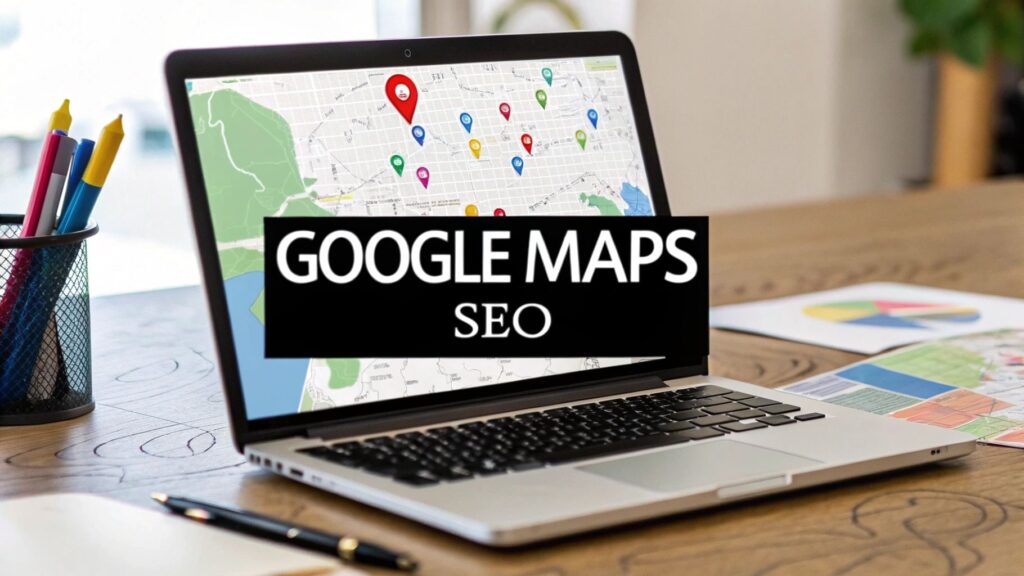Ever wonder why one pizza place always shows up first on Google Maps? It’s not magic, and it’s definitely not luck. There's a strategy behind it, often driven by a Google Maps ranking service.
This guide breaks down what these services do. We'll cover how Google ranks businesses and what you can do to improve your spot. A good service helps you show up in the ‘Local 3-Pack’—that prime real estate at the top of Google search results.
What Is a Google Maps Ranking Service?
A Google Maps ranking service is like a personal trainer for your business's local search presence. Its job is to get your online profile in shape so you rank higher on Google Maps.
Instead of you spending hours figuring out Google's algorithm, these services use proven techniques. They focus on the signals that tell Google your business is legitimate, relevant, and liked by local customers.

Why is Google Maps ranking important?
If your business relies on local customers—like a dentist, plumber, or restaurant—visibility on Google Maps is essential. It's the digital version of having the best spot on main street.
A high ranking means more visibility, more phone calls, and more customers walking in.
Since its launch in 2005, Google Maps has become the world's top navigation app. Over one billion people use it every month. It lists more than 200 million businesses. Data shows that over 68% of users trust the Local 3-Pack, making a top spot critical. You can find more Google Maps statistics on keystaragency.com.
In Short: A Google Maps ranking service uses specialized expertise to improve your local search ranking, turning online searchers into real customers.
What does a Google Maps ranking service do?
A good service combines several key activities to boost your local authority.
| Service Component | What It Involves | Why It Matters for Ranking |
|---|---|---|
| GBP Optimization | Filling out every section of your Google Business Profile with accurate, keyword-rich info. | This is your online storefront. A complete profile tells Google you're a legitimate business. |
| Citation Building | Listing your business name, address, and phone number (NAP) consistently across online directories. | Consistent NAP acts as a vote of confidence, verifying your location and legitimacy. |
| Review Management | Actively encouraging customer reviews and responding to both positive and negative feedback. | Reviews are a huge trust signal. Google likes seeing fresh, positive feedback. |
| Local Content Creation | Developing blog posts or web pages focused on your local area and services. | This signals to Google that you are an authority in your specific geographic area. |
| On-Page SEO | Optimizing your website with local keywords, schema markup, and mobile-friendly design. | A strong website reinforces your GBP profile, telling Google your digital presence is cohesive. |
| Local Link Building | Earning links from other local businesses, community sites, or news outlets. | These are like local endorsements that tell Google you're a trusted part of the community. |
It’s a comprehensive approach that builds a powerful local presence over time.
How Google Decides Who Ranks First
Why do some businesses show up first? It's about convincing Google your business is the most helpful and trustworthy answer for a local search.
Google’s algorithm boils it down to three key factors: Proximity, Relevance, and Prominence.
A great Google Maps ranking service knows how to optimize your business for all three.
The First Pillar: Proximity
Proximity asks: How close is the business to the person searching? You can't change your location, so this factor is fixed.
If you search for a "coffee shop near me," Google shows you the one around the corner first.
But proximity is just the starting point. A business that's a little further away can outrank a closer one if it does better on relevance and prominence.
The Second Pillar: Relevance
Relevance is about matching. Does your business offer what the person is searching for?
Google relies on the information you provide. When someone searches "emergency plumber," Google scans business profiles for those keywords.
Here's what helps Google see your relevance:
- Your Categories: Choosing "Plumber" as your primary category is key. Adding secondary categories like "Water Heater Installation" helps you appear in more specific searches.
- Your Services List: List everything you do, like "drain cleaning" or "leak detection." More detail helps Google match you to the right customers.
- Your Business Description: Clearly explain what you do and where, using the language your customers use.
In Short: Relevance is about making it obvious to Google what you offer so you appear in front of the right people.
The Third Pillar: Prominence
Prominence is another word for your business's reputation. How well-known and respected are you?
Google measures this in a few key ways:
- Reviews: The number of reviews, your average star rating, and how recent they are are huge trust signals. Responding to reviews also shows Google you’re active.
- Citations (NAP Consistency): Google checks your Name, Address, and Phone number (NAP) on sites like Yelp and local directories. If the info is consistent, Google trusts you more.
- Website Authority: Google also looks at your website. If your site has strong SEO, some of that authority helps your Maps profile.
- Local Backlinks: When a local news site or another respected local business links to your website, it's a vote of confidence.
A solid ranking strategy builds your prominence over time.
The Playbook for Dominating Local Search
So, what does a Google Maps ranking service actually do to get you to the top? It's a coordinated playbook of strategies designed to build trust with Google's algorithm.
Let's look at the tactics professionals use.

Building the Foundation with Google Business Profile Optimization
Your Google Business Profile (GBP) is the cornerstone of your Maps presence. An empty or incomplete profile doesn't inspire confidence.
A professional service ensures every field is filled out completely and strategically.
- Choosing the Right Categories: They pick primary and secondary categories that match how customers search for you.
- Writing a Keyword-Rich Description: They craft a description that sounds natural but includes key search terms.
- Uploading Geo-Tagged Photos: High-quality photos of your work, team, and location are a must. Geo-tagging them adds extra proof of your location.
- Leveraging Google Posts: Using Posts for updates, offers, and news shows Google you’re active.
Creating Consistency with Local Citation Building
Inconsistent business information confuses Google.
Local citations are mentions of your business's Name, Address, and Phone number (NAP) on other websites like Yelp or industry directories. A key part of any Maps ranking service is making sure this information is 100% consistent. Perfect consistency builds trust.
That's why Mastering Business Listing Management is a core part of the service.
Driving Trust with a Proactive Review Strategy
Reviews are the lifeblood of local search. They are genuine feedback from real customers.
A good service doesn't just wait for reviews. They use a proactive strategy to:
- Generate New Reviews: They set up simple ways to encourage happy customers to share feedback.
- Respond to All Feedback: They reply promptly to all reviews, good and bad.
- Monitor Review Velocity: They work to keep a steady stream of new reviews coming in.
In Short: A strong review profile tells Google how reputable your business is in the local market.
Reinforcing Relevance with Localized Content
Google also looks at your website to see if you're a local expert. This is where localized content helps.
A ranking service can create content for your website about the neighborhoods or towns you serve. For example, a plumber in Chicago might have a page on "Emergency Plumbing Services in Lincoln Park."
This strategy does two things:
- It sends signals to Google that you are an expert in those specific areas.
- It helps you show up in regular organic search results for location-based keywords.
These tactics create a powerful, all-encompassing approach to dominate the local market.
How to Choose a Google Maps Ranking Service
Picking a Google Maps ranking service is a big decision. Not all providers are the same. A great partner will be transparent and care about your success.
The economic impact of Google Maps is huge, growing to an estimated $11.1 billion in revenue by 2023. With over 200 million businesses listed, getting expert help is critical. You can learn more about Google Maps' powerful role in the advertising ecosystem on electroiq.com.
Key Questions to Ask Any Potential Partner
Before signing a contract, vet any potential agency.
Here’s a checklist of questions:
- How do you measure success? They should talk about real business results: phone calls, direction requests, website clicks, and leads.
- What's your strategy for building local citations? A pro will talk about cleaning up existing listings first, then building new ones on high-quality directories.
- Can I see a sample report? A good report should be clear and show what work was done and what the results were.
- How do you manage reviews? They need a system for encouraging new reviews and responding to all of them.
- What kind of access will I have to my Google Business Profile? You should always own your business profile. An agency should only be a "manager."
Understanding Common Pricing Models
Understanding pricing models for Google Maps ranking services helps you find one that fits your budget.
- Monthly Retainer: You pay a set fee each month for ongoing work. This is best for steady, long-term growth.
- Project-Based Fee: A one-time fee for a specific task, like a profile audit or citation cleanup campaign.
- Performance-Based Pricing: The fee is tied to results, like the number of leads. Read the fine print carefully.
In Short: A good agency will be upfront about their pricing and clearly explain what you're paying for.
Red Flags to Watch Out For
Knowing what to avoid is critical. Some agencies use risky tactics that could get your business penalized.
Be cautious of any service that:
- Guarantees #1 rankings. No one can guarantee a specific spot on Google.
- Is secretive about their methods. If they won’t tell you what they’re doing, they might be using "black-hat" techniques.
- Has poor communication. A true partner provides regular updates and is easy to reach.
For more on how these strategies work, see our guide on local SEO services for small business.
How to Know if Your Google Maps Campaign Is Actually Working
So you hired a Google Maps ranking service. How do you know if it's working? Success is about seeing real, measurable results that lead to more customers.
We track specific metrics, known as Key Performance Indicators (KPIs), that tell the story of your business's growth online.
The Metrics That Actually Matter
Focus on data that translates directly to business results.
Here’s a look at the most important KPIs to track.
Key Performance Indicators (KPIs) for Google Maps SEO
| KPI (Key Performance Indicator) | What It Measures | Why It's Important |
|---|---|---|
| Local Pack Rankings | Your position in the top 3 map results for key terms. | This is prime real estate that dramatically increases calls and foot traffic. |
| Website Clicks from GBP | How many people click from your profile to your site. | Shows high interest from users who are deeper in the buying process. |
| Phone Calls from GBP | The number of calls made directly from your profile. | This is a hot lead—a direct line to a potential paying customer. |
| Driving Direction Requests | How many users request directions to your location. | This is the ultimate buying signal. Someone is planning a trip to your business. |
| GBP Profile Views | The total number of times your profile was viewed. | Indicates overall brand visibility and the effectiveness of your optimization. |
| Review Count & Rating | The number of new reviews and your average star rating. | Social proof builds trust and influences customer decisions. |
Keeping an eye on these KPIs gives you a clear picture of your campaign's performance.
Setting Realistic Expectations: This Isn't an Overnight Fix
Local SEO is a marathon, not a sprint. It takes time for Google to reward the hard work. If someone promises a #1 spot in a week, they're selling a fantasy.
A trustworthy Google Maps ranking service will be upfront about this.
In Short: Patience is key. The goal is to build a solid foundation that generates leads for years.
Your First 90 Days: A Realistic Timeline
Progress comes in waves. The first month is for laying the groundwork. After that, you'll start seeing real engagement.
- Month 1 (Days 1-30): Foundation Phase
- What's Happening: Audits, GBP fine-tuning, and fixing inconsistent listings.
- What to Expect: A small bump in profile views as optimizations kick in.
- Month 2 (Days 31-60): Building Momentum
- What's Happening: Building new citations and implementing a review strategy.
- What to Expect: A noticeable increase in website clicks and phone calls.
- Month 3 (Days 61-90): Seeing Real Growth
- What's Happening: Pushing for more competitive, high-value keywords to break into the Local 3-Pack.
- What to Expect: An undeniable upward trend in calls and direction requests.
If you're wondering where you're starting from, a local business SEO assessment is the perfect first step.
Your First 90 Days: A Results-Focused Roadmap
The first three months are make-or-break. This is when the foundation for long-term results is built. It’s a methodical process of auditing, fixing, and building your authority in Google’s eyes.
Here’s a snapshot of what that journey typically looks like.

It's a staged process. We start with foundational work before expecting real-world results like phone calls.
Month 1: Laying the Foundation
The first 30 days are about deep cleaning and setting the stage. Think of it like prepping soil before planting seeds.
Here’s the checklist:
- Deep-Dive Audits: Analyzing your current Google Business Profile, website, and online listings to find weak spots.
- Competitor Reconnaissance: Figuring out what your top local competitors are doing right.
- Total GMB Overhaul: Optimizing every part of your Google Business Profile—categories, services, photos, and description.
Month 2: Building Authority
Month two is about building your business's credibility. We start sending signals to Google that you're a trusted player.
The main goals are:
- Citation Cleanup and Building: Hunting down and fixing every inconsistent business listing. Mismatched information confuses Google.
- Launching a Review Strategy: Putting a system in place to encourage happy customers to leave feedback.
Month 3: Driving Local Relevance
By month three, it’s all about proving to Google that you are the expert in your service area.
You can expect your team to be working on:
- Hyper-Local Website Content: Creating blog posts or service pages on your website that talk directly to the neighborhoods you serve.
- Local Link Building: Earning "shout-outs" from other local businesses, blogs, or news sites.
People Also Ask About Google Maps Ranking Services
If you're thinking about how to get your business noticed on Google Maps, you probably have a few questions. Let's tackle some common ones.
How can I improve my ranking on Google Maps?
To improve your ranking, focus on Google's three main factors:
- Relevance: Make sure your Google Business Profile is complete and accurate. Use the right categories and list all your services.
- Proximity: While you can't change your location, ensure your address is correct and consistent everywhere online.
- Prominence: Build your online reputation. Get more positive reviews, build local citations, and earn links from other local websites.
How do I get my business in the top 3 on Google Maps?
Getting into the Local 3-Pack is highly competitive. It requires a comprehensive strategy. You must fully optimize your Google Business Profile, actively manage and respond to reviews, and build a strong, consistent presence across local directories (citations). Your website's local SEO also plays a big role. Consistent, long-term effort is key.
Does paying Google help with Maps ranking?
No, paying Google for ads does not directly improve your organic (unpaid) ranking on Google Maps. Google Ads for Maps can place your business in prominent "sponsored" positions, but this is separate from your natural ranking. A Google Maps ranking service focuses on improving your organic ranking through SEO, which provides long-term value without ongoing ad spend.
In Short: A complete strategy often combines organic SEO for lasting authority and paid ads for quick, targeted campaigns.
How long does it take to see results from Google Maps SEO?
It depends. You'll likely see some early movement, like more profile views, within the first 30 to 60 days.
For a solid spot in the Local 3-Pack, plan for a 3 to 6-month journey. Factors like your starting point and local competition affect the timeline.
Ready to stop guessing and start ranking? The experts at Clicks Geek use proven strategies to get your business seen by more local customers. Get your free proposal today!
Is Your Business Ranking in Google Maps?
Turn Google Maps into a Lead Engine w/ Clicks Geek’s AI-powered local SEO. 3,000+ clients served. Our proprietary, fully done-for-you Maps SEO system handles everything—keyword targeting, local optimization, content, reviews, and ranking strategy—automatically.






